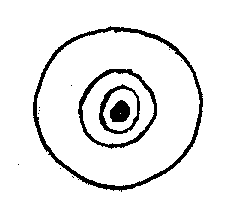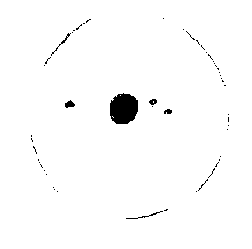
According to the Aristotlean view of the universe, all things revolve around the earth. Thus, only one center of rotation was allowed. Unfortunately, Galileo discovered several problems with this statement. Jupiter, for one, had four objects orbiting it, and these four objects thus did not have a center of rotation around the earth. Either Aristotle or Galileo had to be wrong. Galileo was not going to give up his quest for truth.
Galileo's Observations
Galileo first put forth his observations on the moons of Jupiter in his book Siderius Nuncius. He studied Jupiter over the course of a month and was able to show the movement of the satellites around Jupiter.
Here is a sample of his observations as put forth in Siderius Nuncius, page 75.
He determined that the periods of the four moons were 42 hours, 3.5 days, 7 days, and 16 days (Siderius Nuncius 118-119). Galileo was using a telescope with a 20x magnification, though 15x would be enough to see the moons, according to Dr. Albert Van Helden (Siderius Nuncius, 64n75). He faced a series of difficulties in gathering his observations. These include optical imperfections such as spherical and chromatic abberations. These made Jupiter appear ill-defined and surrounded by prismatic colors (Siderius Nuncius, 13-14). Galileo solved these problems by stopping down his aperture, which decreased the field of view but also alleviated the problems caused by the brightness of Jupiter.
Our Observations
Due to the poor weather conditions and a somewhat less powerful telescope of about 9x magnification, we were unable to observe in the detailed manner of Galileo. Our telescopes thus did not allow us to view the moons of Jupiter at all, or even to make any observations but that it was a planet with no distinguishable markings. Jupiter appeared, in our Galilean telescopes, to be a bright disk surrounded by rings of light. No moons were seen in the area, possibly due to the light surrounding the planet, but also quite possibly due to the magnification of the telescope. So we were forced to use a higher power telescope, an 8in Newtonian Reflector with a 32x magnification, to make observations of the moons of Jupiter. Our observations (Galilean telescope and more powerful telescope) are shown below, as is an example of Galileo's observations of the satellites for comparison.
Here are two observations of Jupiter made through the Galilean telescope. Jupiter appeared to be disk-shaped and surrounded by rings of light. Both are shown in the field of view of the telescope. The first observation was made at about 4:50 am April 15. The second was made at 3:30 am April 21.


As you can see, Galileo could clearly see the moons, whereas our observations were much more limited with the Galilean telescope. The picture is from Siderius Nuncius page 75.

Here are two observations made by higher powered telescopes. The first by the 8 inch Newtonian Reflector and the second by a 4 inch home-made reflector. These show the approximate positions of the moons on April 15 at 4:50 am and 21 at 3:30 am, respectively. The first picture also includes a star, located at the far right in the drawing. The second picture is shown in the field of view of the telescope.


Suggestions for Further Studies of Jupiter's Moons
Several problems which plagued us might be alleviated in further trials. These include the magnification of the telescope, which needs to be at least 15x, not 9x. The telescope might also be improved by stopping the aperture, which should cut down the amount of light that is surrounding the planet in our observations. Other improvements might be a more amiable time of the year weather-wise; this would allow more viewing time and a possible charting of the moons' paths.














 We appreciate any comments or suggestions.
We appreciate any comments or suggestions.